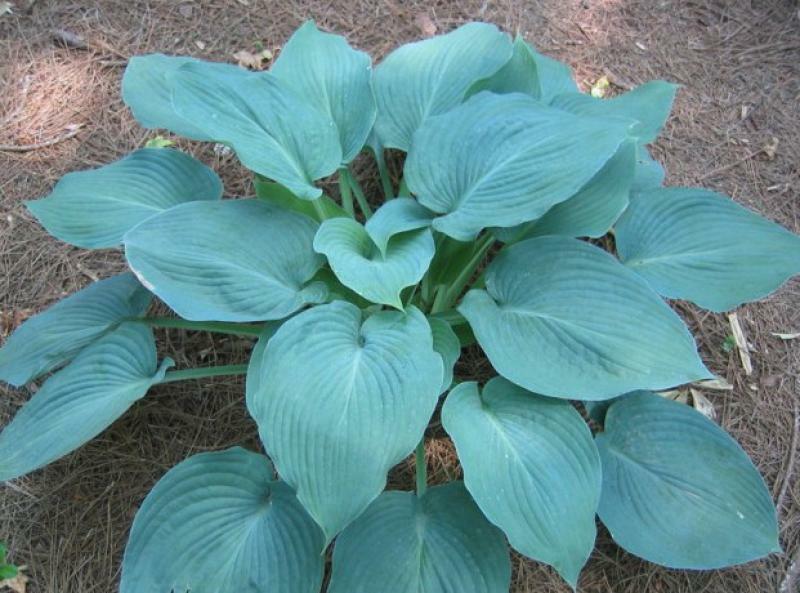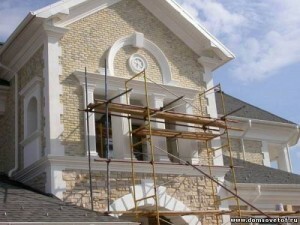Heating in a private home: a review and comparison of options
Table of contents
- 1 Head-on: a comparison of operating costs
-
2 Small text: especially energy
- 2.1 Electricity
- 2.2 Diesel fuel
- 2.3 gasholder
- 2.4 Wood, coal (traditional boilers)
- 2.5 gas main
- 3 Power
-
4 heat transfer agent
- 4.1 Water
- 4.2 Air
- 4.3 A special case: the distribution of heating
-
5 Water heating apparatus
- 5.1 Natural and forced circulation
- 5.2 One and two bottling
- 5.3 Open and closed
-
6 In pursuit of convenience and efficiency
-
6.1 LPs solid fuel boilers
- 6.1.1 pyrolysis
- 6.1.2 upper combustion
- 6.1.3 Automatic (coal or pellet)
- 6.2 Schemes with accumulator tank
-
6.1 LPs solid fuel boilers
- 7 I did so
- 8 conclusion
Greetings, comrades! Several years ago, I moved out of the apartment in a private house, and immediately faced with the problem of its heating. In search of a solution, I had a long time to explore options of housing heating. With some of them, I want you to meet.
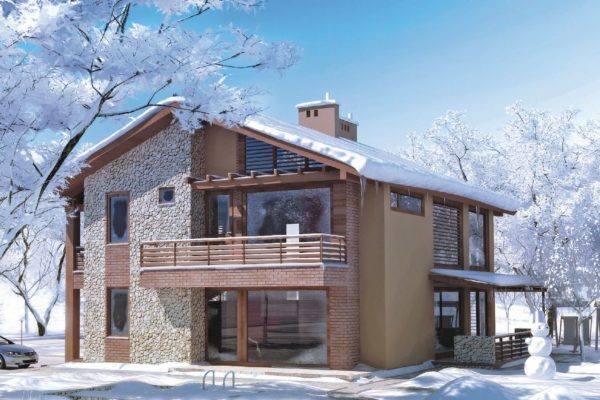
The walls, roof and windows do not do residential house. He needs a heating system, which we will discuss today.
Head-on: a comparison of operating costs
What is the main requirement of the owner makes to the heating system in a private home? The answer is obvious: it must be economical. Let's compare the different heat sources at a cost of a kilowatt-hour of energy.
At the moment (beginning of the year 20174) are lined up in this order:
- Natural gas (Trunk) - 0.7 P .;
- Firewood - 1.1 p .;
- Pellets (Granular sawmill waste) - 1.4-1.5 P .;
- Coal - 1.6 p .;
- Propane-butane from gas tank (assuming it fill at lower prices years) - 2.5 P .;
- Diesel fuel - 3.5 p .;
- electric power - 5 p.
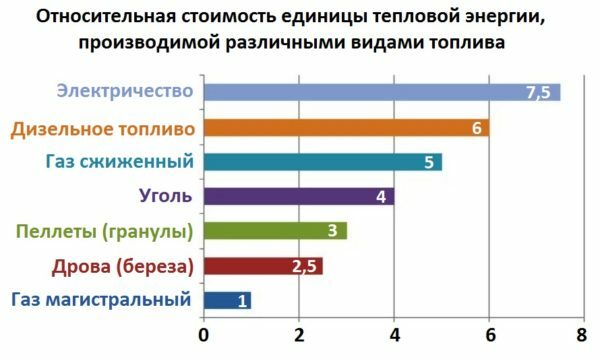
Comparative cost of energy. For conventional unit accepted price per kilowatt-hour heat obtained from the combustion of the main gas.
Exact prices in your area may differ from the above. They are determined by the availability of energy resources and the local utility rates. For example, in Sevastopol, where I live, the pellets are 15 thousand rubles per ton, compared with 7000 in the Moscow region.
Small text: especially energy
The choice of a decision not only affect operating costs. The important role played by the cost of equipment installation and ease of use.
Electricity
Electric heating - the most accessible and convenient. Let me explain this:
- affordable energy: The ability to connect to electricity have on any site designated for individual housing construction, by default. There are only power constraints;

Construction of any settlement begins with the territory of electrification.
- Cost of equipment: TENovye electric boiler with a capacity sufficient for a small house (3-6 kW) can be purchased for 8-10 thousand rubles. Cheaper only much less comfortable heating furnace for solid fuels;
- The convenience of use: Electric boiler does not require periodic maintenance, kindling and discharge of the combustion products. It indefinitely maintains a predetermined temperature of the coolant in the automatic mode.
Modern electric boilers compatible with remote thermostats (including programmable), which allows to maintain a constant air temperature and cyclically adjust it depending on the time of day and day of the week (for example, lowering the temperature at the time when you are at work, and increasing it in weekends).
Diesel fuel
What is the diesel boiler from the competition?
affordable energy: Sold at any gas station. Reserve Solarium, however, have to be stored in the boiler room: part of the room takes a tank volume of several hundreds or even thousands of liters.

Boiler with diesel fuel will take part of the boiler room area.
Cost of equipment: From 25,000 rubles per floor boiler with minimal functionality.
The convenience of use:
- Boiler maintenance requires every 6-12 months and reduces to a soot cleaning nozzle and the deflector burner;
- The boiler is compatible with an external thermostat, and automatic control of heating systems;
- Servicing and kindling for obvious reasons, are not required. Heating in the house works as long as there is fuel;
- Unambiguous cons - diesel odor and noise during burner operation.
gasholder
affordable energy: For filling the gas tank is enough to call the local Gorgaz. Of course, the cost of refueling will be included delivery of propane-butane to your home.
Cost of equipment: Boiler - from 15 000 rubles at the minimum functionality. Gasholder with the installation of turnkey - from 200 000 rubles.
Gasometer is installed into the ground, so the need to prepare your yard free of hozpostroek and landing pad in 6-15 square meters.
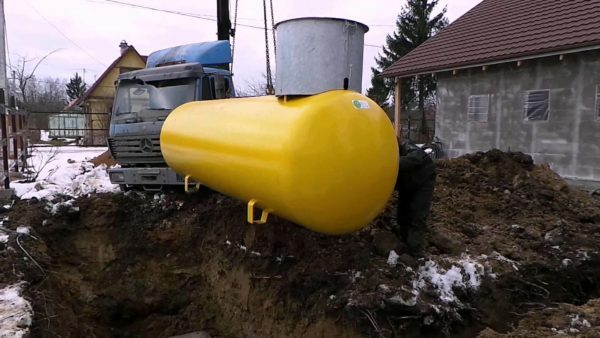
Installation of the gas tank in the cottage yard. Part of the usable area had to be sacrificed.
The convenience of use:
- Servicing is required the boiler once a year;
- Gasometer dressed every 6-12 months. The large volume of the gas tank allows you to refuel once a season low summer prices, but will require large investments in the heating installation stage house;
- The boiler operates until complete emptying a gas container.
Wood, coal (traditional boilers)
- affordable energy: And the wood and coal are available for home delivery in the vast majority of localities of the country;
- Cost of equipment: 22,000 rubles for a wood-burning boiler with a capacity of 10-16 kW;
- The convenience of use: Kindling boiler is required every 3-6 hours. Cleaning the ash box is necessary at least once a day.

Kindling solid fuel boiler: initially ignite the wood, then from them ignited coal.
gas main
affordable energy: 2/3 of the settlements on the territory of Russia (as of 2016 - 66.2%).
Even if passed gas pipeline, the gas is still necessary to get into the house on your street. To do this, create a gasification project and pay for services Gorgaza employees or other certified companies by connecting the house and the installation of gas equipment.
Cost of equipment: Inexpensive gas boiler will cost 15-20 thousand rubles. But the cost of connection is determined by local conditions (distance from the motorway, terrain, presence between you and the backbone of foreign households, streets, etc.) and ranges from 50 to 000 million and more.
Ease of use: The level of comfort gas equipment is not inferior electrical. With only one correction: it needs to remove combustion products. Therefore, the gas boiler has to provide a chimney or (if it has an overpressure burners) mounted on an outer wall of a house and to output therethrough coaxial inlet.
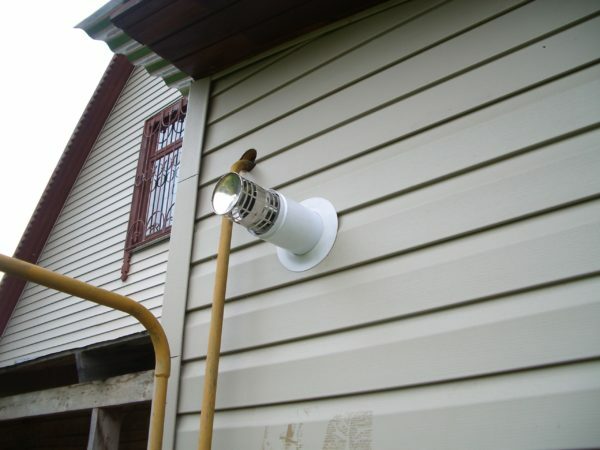
Coaxial flue gas boiler. As the outer shell shown in the air for the burner, the combustion products are discharged on the inner tube.
Power
How is the power of the boiler?
Device to compensate the heat loss through the building envelope. Accordingly, its capacity is determined by the characteristics of the heated space.
The most versatile and easy calculation scheme takes into account:
- heated volume (I emphasize - and the area of the house, and the height of its ceilings);
- quality insulation (Insulating quality of the walls and the glazing of windows);
- climate zone. It is understood that for bracing or frost Chegdomyn Yakutsk to -50 ° C house will lose more heat than 5 in Crimean.
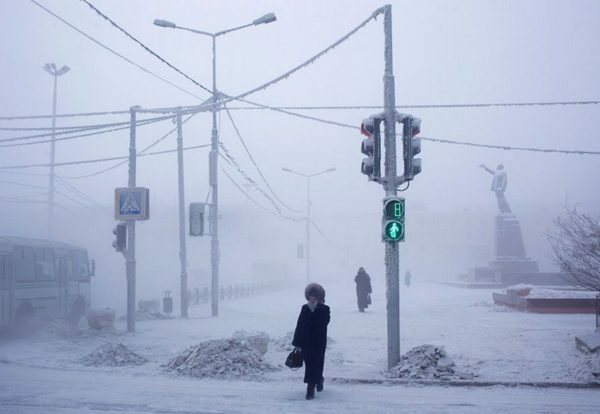
Winter temperatures greatly affect the heating energy consumption.
The formula for calculating the heat loss is given by Q = V * Dt * k / 860. Variables in it from left to right:
- Need home warm in kilowatts;
- The volume of heated space in cubic meters;
- The maximum temperature difference between house and street in degrees Celsius;
- The coefficient of thermal insulation of buildings.
Dt and k parameters require my comment.
The temperature difference with the street is calculated as the difference between the norm and the temperature of the sanitary coldest five consecutive days in a cold season. Sanitary standards for private homes are:
- In regions with minimum winter temperatures above -31 ° C - 20 degrees;
- In regions with colder winters - 22 degrees.
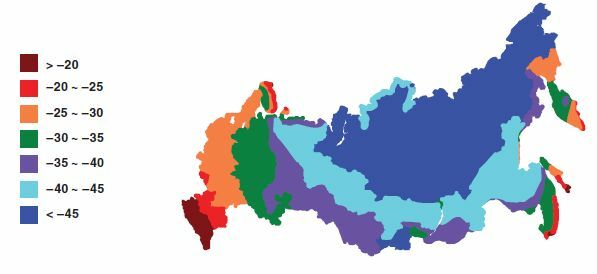
To know the temperature of the coldest five-day week in your area, find it on the map.
The coefficient of insulation you can pick up from the table.
| Picture | The coefficient of thermal insulation and a description of the building |
 |
0,6-0,9: External insulation of facades with mineral wool or foam, triple or energy efficient windows |
 |
1-1,9: Double glazing, masonry brick in 2 (50 cm thickness) |
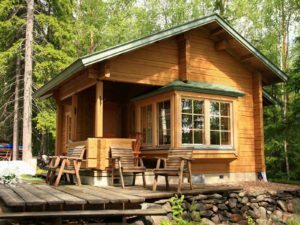 |
2-2,9Walls of the 10-centimeter-beam, glazed in a single thread |
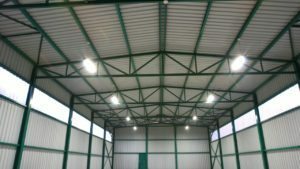 |
3-4: Shield house without insulation, cold storage |
Let's take, as an example of computing needs at home in the warmth under the following conditions:
- Heated volume - 440 cubic meters;
- Location - Sebastopol (temperature of the coldest five days - -14 degrees);
- Wall thickness of 40 cm Inkerman stone (Insulationworks - analogue masonry bricks in the two), the windows - double glazing.
The coefficient of thermal insulation take equal to 1.5.
temperature difference between the street and house is (20 - -14) = 34 degrees.
Substitute the data into a formula: Q = 440h34h1,5 / 860 = 26 kW.
heat transfer agent
Water
Traditional heating scheme involves the use of a liquid coolant (water or antifreeze). The only source of heat - the boiler is responsible for its heating. Heat transfer medium transports the heat energy and releases it into the room air by means of heating devices.
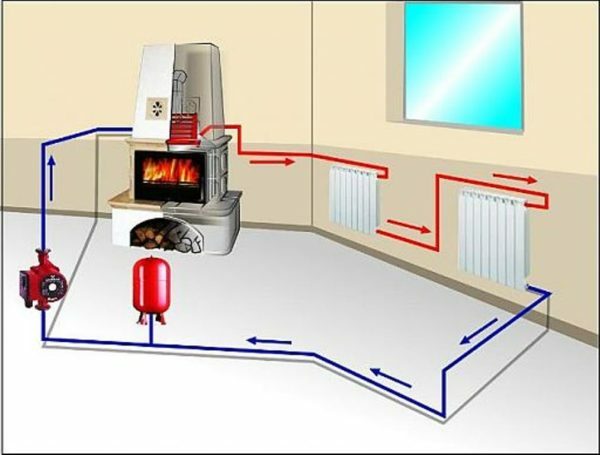
The coolant carries the heat from a single source around premises to be heated.
Benefits:
- A small section of lines for the coolant. Tubes do not require considerable diameter owing to the high heat capacity of water and various nezamerzaek;
- It can be installed at any stage of construction. Dilute tubes and hang the battery is possible even after finishing.

Dilute water heating and radiators can be set after the repair or decoration.
Air
Air heating means heat transfer heated boiler or furnace and air is usually combined with a ventilation system. heat capacity of air is hundreds of times smaller than water, so the air ducts have to move its large volumes.
To reduce heat loss through the ventilation air heating system is provided with recuperators, takes energy from the exhaust air and give it to the supply.
Benefits:
- Forced ventilation performance, and therefore - always fresh air in the absence of odors;
- No visible radiators.
disadvantages:
- A large section of the duct. For the sake of their pads have to sacrifice valuable space;
- Can be installed only at the time of construction or renovation. After completion of finishing works air ducts have to be laid open, that disfigure any design.
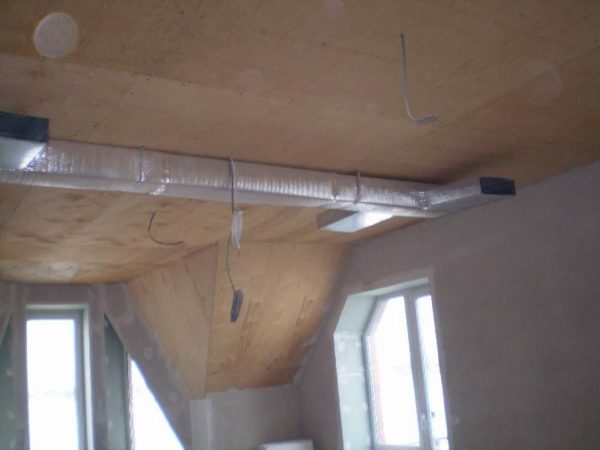
air heating ducts. They will be hidden when installing suspended ceilings.
A special case: the distribution of heating
In some cases, the heating system in a private home can do without coolant.
How so?
It's very simple: every room is provided with its own source of heat, independent of the other. These sources include:
- gas convectors - a furnace with an overpressure or atmospheric burner, directly heating the air in the room, and discharge heat through the coaxial duct outside. Installation of the gas convector in each room implies wiring gas throughout the house;
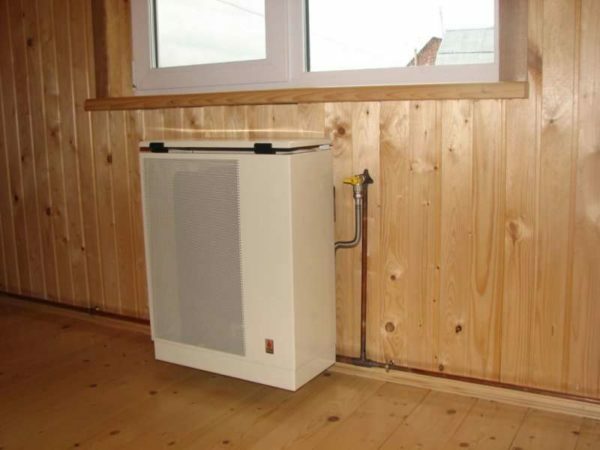
Gas convector gas requires wiring throughout the house.
The source of gas for the convector can serve not only as an offshoot of the trunk, but also a propane tank.
- The heaters or electric radiators. They are connected to a conventional power outlet and create a distributed load on the wiring, eliminating the need for a separate cable to the shield;
- Electrical floor heating in each room. Film heating elements or cable connected to the power supply through independent thermostats located in each room.
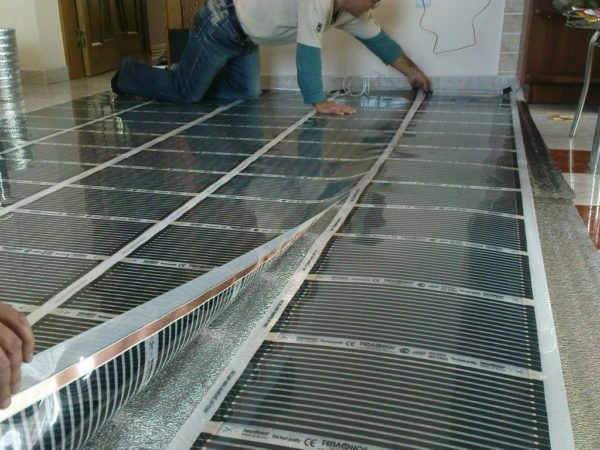
Film electrical Heated floor - a special case of the distributed heating. Each room is equipped with its own heat source.
Benefits:
- Absence of spills or heating duct;
- The highest fault tolerance of the system as a whole. Failure of any of the device does not affect the other; remained without heat to warm the room will be located in the neighboring devices through the open door.
Water heating apparatus
and an air heating system are distributed fairly moderate popularity: the first - because of the complexity of installation, the second - because of the limited choice of heat sources. Therefore, I will focus on the unit water system. So how can it be implemented?
Natural and forced circulation
Water heating with forced circulation involves the use of a pump, driving the coolant. The circulation pump is installed in the dispensing gap and is completely submerged centrifugal impeller on a common shaft with an electric motor.
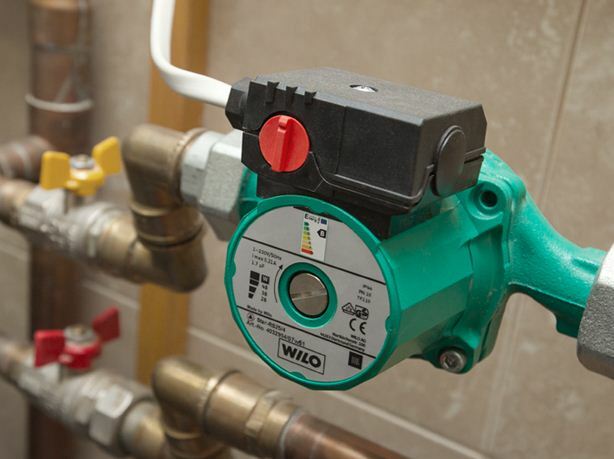
The circulation pump is responsible for the movement of the coolant in the heating circuit.
dignity:
- The high speed of the water or antifreeze so - quick and uniform heating of radiators;
- Small diameter spills. The increase in flow resistance while reducing the useful section will help overcome the pump;
- The ability to create multiple independent circuits with different velocities coolant flow and at different temperatures (e.g., radiator heating and floor heating water).
shortcoming: Volatility. the pump will rise, and you will be without heating when switched off the light.
Water in a natural circulation system is driven by the difference in density between the hot and cold coolant. Upon heating the water density decreases, and it is forced out of the cold mass to the upper portion of the contour. From there, the cooling heat transfer fluid moves along the inclined pouring by gravity, gradually giving heat to the batteries.

Open gravity system. The difference in height H between the boiler and radiators creates hydraulic pressure in the circuit.
Dignity: Volatility. For the heating system only source of heat.
disadvantages:
- Uneven heating of the battery at the beginning and end of the loop;
- Uprated diameter filling compensating low hydraulic pressure;
- Inability to create complex multi-loop circuits.
One and two bottling
Water heating systems of private houses are monotube and twin-tube.
Single-pipe systemOr from Leningrad - a single filling ring encircles the home or a separate room on the perimeter. Radiators are connected in parallel bottling.
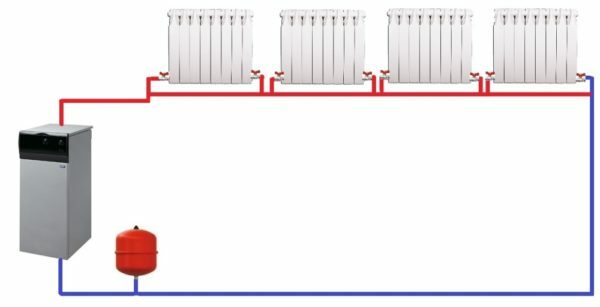
Leningradka in the correct execution: The heater does not break the bottling and connected in parallel to it.
dignity:
- The absolute fault tolerance. While there is at least some difference, all batteries will heat between the loop ends;
- Extreme simplicity and low cost of installation;
- When placing heaters on filling - resistance to airing. The air is forced into the upper manifolds radiators and water circulation is through the lower manifold. In this case, the battery is warmed up the entire height of the sections through conduction.
shortcoming: The temperature difference between the first and last panels.
Two-pipe system It includes separate filling supply and return. Each radiator with a pair podvodok is a jumper between them. Movement of the coolant circuit in the double-pipe may be:
- deadlockWhen the transition from the flow in the opposite thread it changes direction to the opposite one;
- incidental - the direction is maintained.
Dead-end system requires mandatory balancing - throttling podvodok near to the boiler equipment. Otherwise, the bulk of the water will circulate through them, as long radiators to cool down until the defrost.
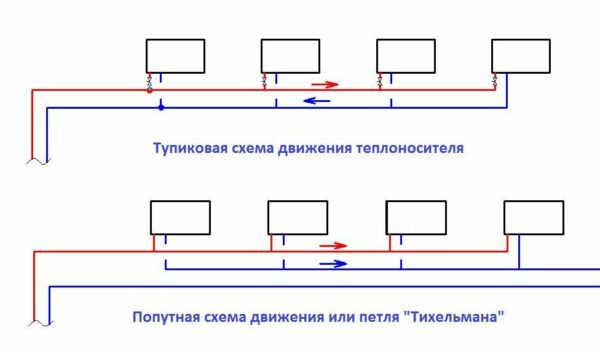
Two varieties of two-pipe routing. Tichelmann loop, as opposed to a dead-end schemes, balancing is not needed.
Dignity: Uniform heating radiators.
shortcoming: Large compared to the single-tube wiring material consumption.
Open and closed
Open heating system is operated at atmospheric pressure and communicates with the atmosphere via the open expansion tank mounted at the top of pouring. Buck combines several functions:
- Holds excess water during its heating and concomitant heat expansion;
- VentingLeft in circuit after starting;
- It serves as a safety valve Boiling of water in the boiler heat exchanger;
- It is used to recharge the system (Topping up the coolant vaporized in return).
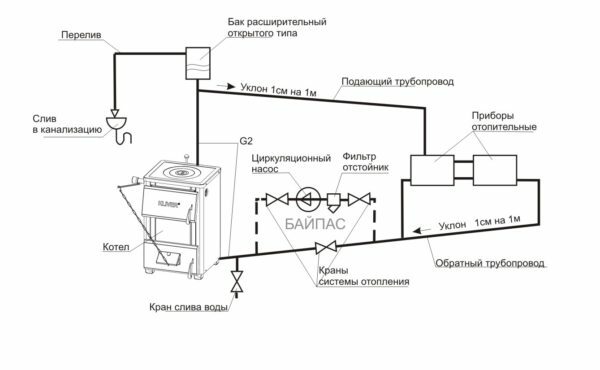
Open system that can operate with forced and natural circulation.
In the closed circuit is maintained off excess pressure 1-2.5 kg / cm2. Regardless of what type of fuel used boiler, a part of its binding should include:
| Picture | binding element |
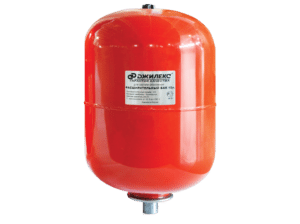 |
Expansion tank (Membrane). It accommodates expanding when heated coolant. Fuel tank roughly calculated as 10% of the coolant volume; installing the circuit at any point at a distance from the circulating pump. |
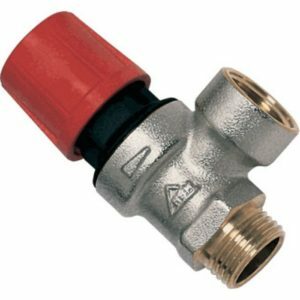 |
Safety valve, Bleed water when pressure exceeding 2.5 atmospheres. During normal operation of the circuit valve is not working and needs only to insurance. |
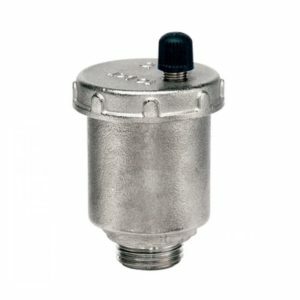 |
automatic air vent. It expels from the closed loop not only air but also gases arising from electrochemical reactions, and steam boiling at the heat exchanger of the boiler. |
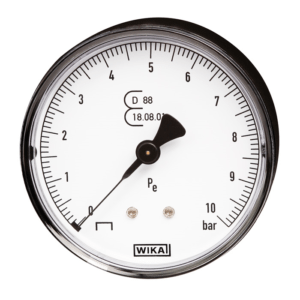 |
manometerThat monitors the pressure visually. |
Valve, pressure gauge and air vent are often assembled in a single unit and are called boiler safety group. The security group is mounted on the outlet of the heat exchanger it: that's where the pressure and temperature begin to rise when all the problems in the first place.
Some boilers are supplied with a circulating pump and a private security group mounted inside the enclosure. Such typical equipment, particularly for wall gas boilers with electronic ignition and electric heaters.
In this case, the arrangement includes only a pair of valves or taps at the inlet and the outlet: they allow to disassemble exchanger boiler or without full discharge of coolant in the circuit.
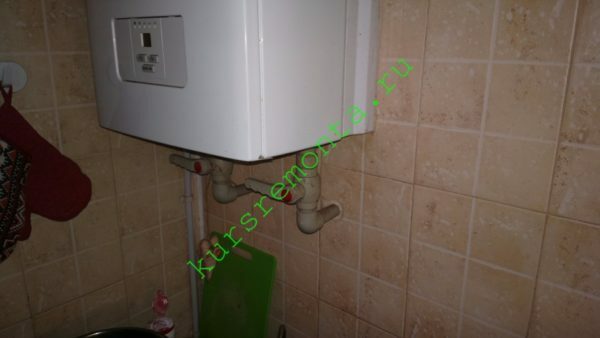
TANS boiler in my house. Arrangement includes two ball valves. Pump, safety group and expansion tank installed by the manufacturer in the case.
In pursuit of convenience and efficiency
Some versions of heating systems can make them more fuel efficient and easy to operate. I will describe the most popular solutions.
LPs solid fuel boilers
Classic wood or coal water boiler for heating private houses require frequent kindling. However, some versions of boilers require much more rare attention from the owner.
pyrolysis
Operating principle: Smoldering wood with limited access to air, followed by incomplete combustion products afterburned in a separate chamber.

Jetstream furnace with forced draft. Burning of the pyrolysis products maintains smoldering wood in the main furnace.
autonomy: 10-12 hours.
upper combustion
Operating principle:
- Wood or coal in bulk furnace ignited from the top;
- Top arranged and movable telescopic air supply duct;
- The duct ends massive steel plate, a separating chamber smolder reburning fuel and combustible gases;
- Ash entrained in the upflow gas flue.
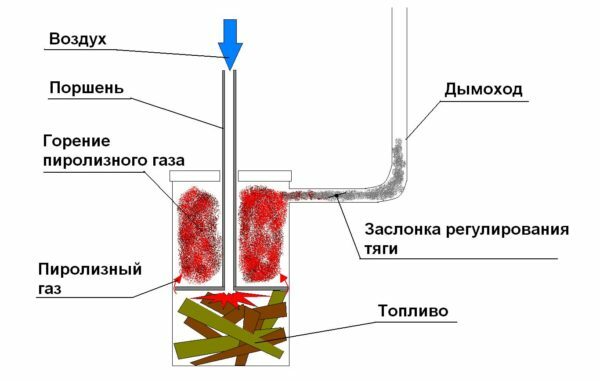
The operating principle of the upper combustion boiler.
autonomy: Up to 31 hours (according to the creator of the boiler - Stropuva Lithuanian company).
Automatic (coal or pellet)
Operating principle: Fuel forcedly fed from a hopper to a drum grate. Filing and rotating grate, pour the ashes in the ash pan, controlled by electronics.
autonomy: Up to a week.
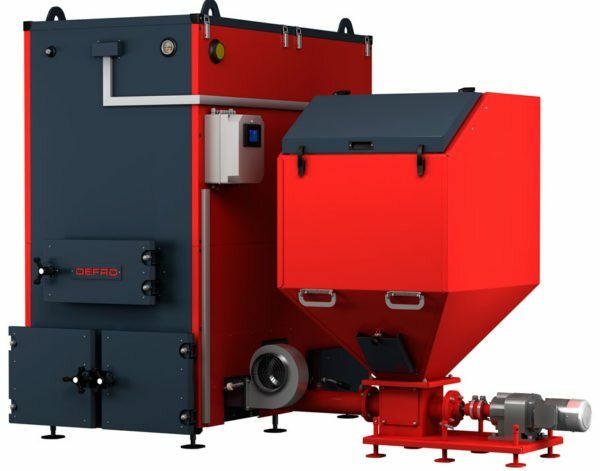
Automatic coal boiler. Autonomy is limited only by the capacity of the hopper.
Schemes with accumulator tank
Heat accumulator or buffer capacity - is insulated tank of large volume (3.5 cubic meters) with fittings for connection to several circuits. The heated water is able to accumulate hundreds of kilowatt hours of heat.
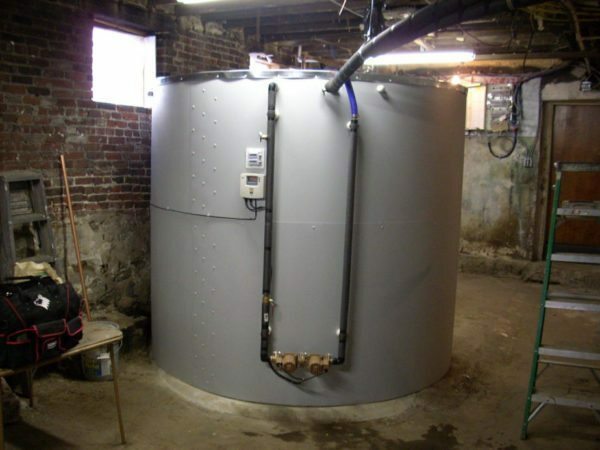
Trehkubovy storage tank in the basement of the cottage.
Reference: 3500 liters of water heated to 40 to 80 ° C allows to stock more than 200 kWh of energy.
Where and how best to mount the heat accumulator?
Instructions are not complicated. The tank is connected between the boiler and radiators. As a result of the formation of two circuit with circulation pump:
| Picture | Description |
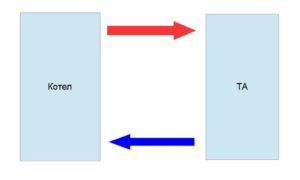 |
Between the boiler and accumulator tank. Water is circulated only in the operation of the boiler. |
 |
Between the accumulator tank and radiator. Water circulates around the clock. |
What gives?
- When you work with the classical solid fuel boiler buffering capacity allows you to make kindling much more rare. The boiler operates at full power short time (and hence with maximum efficiency). Then, within a few hours of stored heat is spent on heating homes;
Autonomy boiler in this scheme determined by its capacity and the volume of the buffer tank. It can reach a day or more.
- When working with electric boiler thermal receiver is paired with two-tariff meter will give you the opportunity to go to the night rate. In the afternoon, during the term of a more expensive fare, the boiler will be idle, and at night - warm water in the batteries and the buffer tank.
heating translation into night rate will reduce the bill for electricity is about three times.

Two-rate meter separately allows for daytime and nighttime power consumption.
I did so
The reader might ask the question: where was I, exhausting every possible heating scheme?
To electric heating. But not quite normal.
Fixed a previous owner of the house was the electric boiler back-up heat source in the case of extremely strong frosts. For the main heating are responsible... air conditioners.
Modern inverter split system is able to pump the house up to 5 kilowatts of heat per kWh of power consumption. The lower limit outside temperature during operation for heating - -15 - -25 degrees. In Sevastopol, even -10 happens not every winter.

Thermal power conditioner pictured at work on heating of 4100 watts. Power consumption - 980 watts.
Inverters are installed in each room of the house. The cost of a split system at the time of purchase was 20-24 thousand rubles; installing each of them cost more in the 3-4 thousand. If you can put the air conditioning with his own hands - great save more.
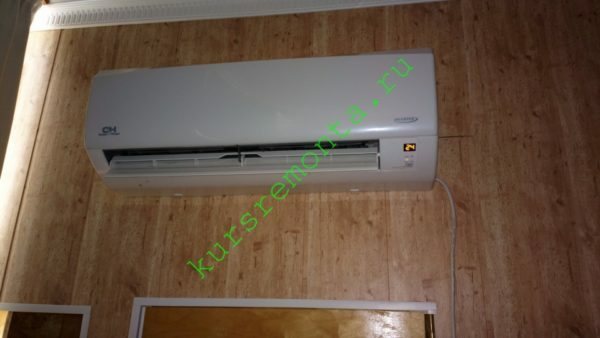
For heating the attic area of 60 squares corresponds to the only air conditioner.
How profitable is the heating? In two month for heating floors area of 155 squares out of 800 to 1500 kWh depending on the outdoor temperature. How much is in rubles at your current rates, you can calculate yourself.
conclusion
I sincerely hope that my experience will help the reader to arrange a convenient and cost-effective heating system in your home. As usual, you can find additional information in the video in this article. Waiting for your additions to it. Good luck, comrades!
